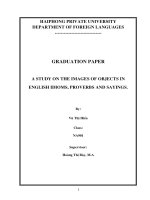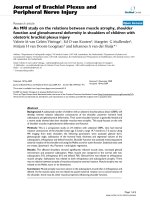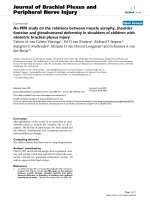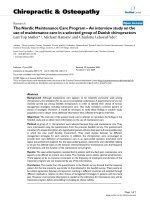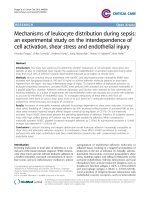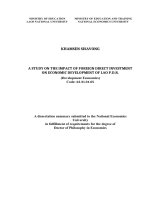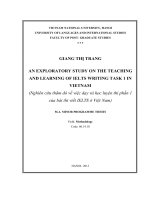An exploratory study on the role of emotions in service satisfaction and loyalty behaviours
Bạn đang xem bản rút gọn của tài liệu. Xem và tải ngay bản đầy đủ của tài liệu tại đây (1.3 MB, 175 trang )
AN EXPLORATORY STUDY ON THE ROLE OF
EMOTIONS IN SERVICE SATISFACTION AND
LOYALTY BEHAVIOURS
THE CASE OF A HOLIDAY RESORT IN SOUTH-EAST ASIA
LEA PIGNIER
A THESIS SUBMITTED
FOR THE DEGREE OF MASTER OF ENGINEERING
DEPARTMENT OF INDUSTRIAL AND SYSTEMS ENGINEERING
NATIONAL UNIVERSITY OF SINGAPORE
2005
Acknowledgements
I would like to thank Dr Chai Kah Hin and Dr Tan Kay Chuan my supervisor and
co-supervisor for their guidance and support throughout this research.
I would like to thank Dr. Chai’s students for their insights and support throughout
this project and for having shared their experience and knowledge with me.
I would also like to thank the managers of the company I worked with, especially
Simon and Nathalie, for having given me the opportunity to fulfil my research
project and for all the things I have learned when I worked with them.
I also would like to thank all my friends in Singapore for having made this stay in
Singapore unforgettable.
I am very grateful to my parents whose constant support was essential among others
to the completion of this project.
Finally, I especially would like to thank Frederic who gave me his support, his help
and so much more all along our stay in Singapore.
i
Table of Contents
ACKNOWLEDGEMENTS............................................................................................................ I
TABLE OF CONTENTS.............................................................................................................. II
SUMMARY .................................................................................................................................. V
LIST OF TABLES ..................................................................................................................... VII
LIST OF FIGURES .................................................................................................................... IX
CHAPTER 1
INTRODUCTION .............................................................................................. 1
1.1
Research background ..............................................................................................................1
1.2
Research objectives..................................................................................................................4
1.3
Thesis structure........................................................................................................................5
CHAPTER 2
LITERATURE REVIEW.................................................................................... 7
2.1
Introduction..............................................................................................................................7
2.2
Emotions ...................................................................................................................................7
2.2.1
Emotion, affect and mood .................................................................................................7
2.2.2
A definition of emotion .....................................................................................................9
2.2.3
Consumption emotions....................................................................................................10
2.3
Satisfaction and other post-consumption processes ............................................................16
2.3.1
Towards a definition of satisfaction.................................................................................16
2.3.2
A review of the theories explaining satisfaction..............................................................18
2.3.3
The expectation-disconfirmation model ..........................................................................21
2.3.4
Loyalty, word-of-mouth and re-purchase intentions........................................................24
2.4
Service.....................................................................................................................................26
2.4.1
The nature of service and its evidence.............................................................................26
2.4.2
Time and duration............................................................................................................28
2.4.3
The customer as a major actor of the service experience ................................................32
2.5
Emotions in a service context................................................................................................35
2.5.1
Emotional content of service ...........................................................................................35
2.5.2
The antecedents of emotions ...........................................................................................37
2.5.3
Emotions and phases of consumption..............................................................................40
2.5.4
The effects of emotions on satisfaction and loyalty.........................................................42
2.6
Conclusion and research questions.......................................................................................45
CHAPTER 3
THEORY AND HYPOTHESES ...................................................................... 50
3.1
Introduction............................................................................................................................50
3.2
Hypotheses and proposed framework..................................................................................50
3.2.1
Service experience as a multiple stages process..............................................................50
3.2.2
Duration, peak and end events.........................................................................................56
3.2.3
Proposed framework........................................................................................................60
ii
3.3
Conclusion ..............................................................................................................................60
CHAPTER 4
DEVELOPMENT AND IMPLEMENTATION OF THE SURVEY .................... 62
4.1
Introduction............................................................................................................................62
4.2
Preliminary interviews ..........................................................................................................62
4.3
Survey design .........................................................................................................................65
4.4
Measures.................................................................................................................................65
4.4.1
Latent variables and corresponding indicators ................................................................65
4.4.2
Control variables .............................................................................................................76
4.4.3
Limitations.......................................................................................................................78
4.5
Testing of the survey instrument ..........................................................................................79
4.6
Surveyed population ..............................................................................................................80
4.7
Survey implementation..........................................................................................................80
4.8
Conclusion ..............................................................................................................................81
CHAPTER 5
DATA ANALYSIS AND DISCUSSION ........................................................... 82
5.1
Introduction............................................................................................................................82
5.2
Preliminary analysis ..............................................................................................................82
5.2.1
Number of responses .......................................................................................................82
5.2.2
Characteristics of respondents .........................................................................................83
5.2.3
Non-respondent bias test .................................................................................................88
5.2.4
Scales analysis .................................................................................................................88
5.2.5
Descriptive statistics......................................................................................................101
5.3
What emotions matter? .......................................................................................................103
5.4
Test of moderating hypothesis ............................................................................................105
5.4.1
Linear regression assumption checking.........................................................................106
5.4.2
Moderating role of length of stay (H4)..........................................................................107
5.5
Structural equation modelling (SEM) ................................................................................ 111
5.5.1
Structural equation modelling assumption checking .....................................................111
5.5.2
Treatment of missing data .............................................................................................113
5.5.3
Estimation of the general model....................................................................................114
5.6
Groups’ comparisons ...........................................................................................................122
5.6.1
European versus Asian ..................................................................................................122
5.7
Influence of peak event........................................................................................................126
5.8
Discussion of research findings...........................................................................................128
5.9
Conclusion ............................................................................................................................135
CHAPTER 6
CONCLUSION ............................................................................................. 137
6.1
Introduction..........................................................................................................................137
6.2
Research findings .................................................................................................................137
6.3
Implications for theory ........................................................................................................141
6.4
Implications for practice .....................................................................................................143
iii
6.5
Limitations of this research and future directions ............................................................144
6.6
Conclusion ............................................................................................................................147
REFERENCES........................................................................................................................ 148
APPENDIX A
QUESTIONNAIRE.................................................................................... 158
iv
Summary
This research investigates the relationships between emotion, customer satisfaction
and loyalty behaviours in the context of a holiday resort in South-East Asia. A
review of the literature reveals that although the role of emotions in the satisfaction
formation process has been the focus of a growing literature, their effect on
satisfaction and loyalty behaviours remains unclear, especially in the context of
extended services such as packaged holiday or vacation in beach resorts which have
a high level of emotional content.
This study endeavours to understand the mechanisms underlying satisfaction
formation and loyalty behaviours. In this project, emphasis is put on the temporal
dimension of service, by distinguishing several phases during the service experience
and by identifying the peak events. Along the various phases of the service, the
different
emotions
elicited
among
customers
and
the
conventional
expectation-disconfirmation model are taken into account. The primary aim of this
research is to answer the question of how customer emotions affect customer
satisfaction and loyalty behaviours in extended services, and more specifically (i)
what are the emotions which affect customer satisfaction and loyalty in extended
services? (ii) What is the impact of emotions at different phases of extended service
on overall customer satisfaction and loyalty? The research focuses on emotions,
disconfirmation of expectations and post-consumption processes. With the help of
v
an international holiday resort company, the interactions between these concepts,
using a temporal perspective of the service experience, were tested in a holiday
resort through a questionnaire survey at the end of the respondents’ holiday.
Statistical analysis is then conducted to study those interactions, as well as the effect
of the length of the stay and peak events on post-consumption processes.
The research process consisted in two phases: (i) the development of a survey
instrument to measure emotions, disconfirmation of expectations, satisfaction and
loyalty, based on literature and preliminary interviews with relevant managers of the
hospitality industry, (ii) survey of the population of a South-East Asian resort over a
15-day period.
Survey findings suggest that (i) negative emotions are negatively related to
satisfaction and loyalty, while positive emotions have no causal effect on satisfaction
and loyalty, (ii) the duration of the experience has a moderating effect on the impact
of emotions since their importance appears to be greater when the experience is
shorter, and a phenomenon of attenuation of effect of emotions over time has been
observed, (iii) previous stages of the service significantly impact subsequent stages
of service.
vi
List of Tables
Table 4-1:
Interviews ......................................................................................................................... 64
Table 4-2:
The constructs of expectations disconfirmation at each phase of the service
experience and their indicators ......................................................................................... 68
Table 4-3:
The constructs of positive and negative emotions at each phase of the service
experience and their indicators ......................................................................................... 74
Table 5-1: Gender of the respondents ...................................................................................................... 85
Table 5-2: Age group of the respondents ................................................................................................. 85
Table 5-3: Nationality of the respondents................................................................................................ 85
Table 5-4: Length of stay of the respondents........................................................................................... 87
Table 5-5: Advance booking .................................................................................................................... 87
Table 5-6: User profile of the respondents............................................................................................... 87
Table 5-7: Party the respondents travelled with....................................................................................... 87
Table 5-8: Inbound/outbound travellers................................................................................................... 87
Table 5-9:
Item-total Statistics for PE1 .............................................................................................. 89
Table 5-10:
Item-total Statistics for NE1 ............................................................................................. 90
Table 5-11:
Item-total Statistics for PE2 (first iteration)...................................................................... 90
Table 5-12:
Item-total Statistics for NE2 ............................................................................................. 91
Table 5-13:
Item-total for NE3............................................................................................................. 92
Table 5-14: DISC1 construct component matrix ..................................................................................... 93
Table 5-15: PE1 construct component matrix.......................................................................................... 93
Table 5-16: NE1 construct component matrix ......................................................................................... 93
Table 5-17: NE2 construct component matrix ......................................................................................... 93
vii
Table 5-18: PE3 construct component matrix.......................................................................................... 93
Table 5-19: NE3 construct component matrix ......................................................................................... 93
Table 5-20: SAT1 construct component matrix ....................................................................................... 94
Table 5-21: LOY construct component matrix ........................................................................................ 94
Table 5-22: Communality statistics for DISC1........................................................................................ 94
Table 5-23: Communality statistics for PE1 ............................................................................................ 94
Table 5-24: Communality statistics for NE1 ........................................................................................... 95
Table 5-25: Communality statistics for NE2 ........................................................................................... 95
Table 5-26: Communality statistics for PE3 ............................................................................................ 95
Table 5-27: Communality statistics for NE3 ........................................................................................... 95
Table 5-28: Communality statistics for SAT1.......................................................................................... 95
Table 5-29: Communality statistics for LOY........................................................................................... 95
Table 5-30: DISC2 construct component matrix ..................................................................................... 96
Table 5-31: Communality statistics for DISC2........................................................................................ 96
Table 5-32: PE2 construct component matrix.......................................................................................... 97
Table 5-33: Communality statistics for PE2 ............................................................................................ 97
Table 5-34: BMEMO construct component matrix ................................................................................. 97
Table 5-35: BMEMO construct rotated component matrix (Varimax rotation) ....................................... 97
Table 5-36:
Total Variance Explained for BMEMO construct ............................................................. 98
Table 5-37:
Disconfirmation of expectations constructs...................................................................... 99
Table 5-38:
Emotional constructs ...................................................................................................... 100
Table 5-39:
Endogenous constructs ................................................................................................... 101
viii
Table 5-40:
Descriptive statistics and correlation coefficients........................................................... 102
Table 5-41:
Correlation table of emotions and post-consumption processes ..................................... 104
Table 5-42:
Test of moderating effect of the length of stay on the relationship between the
constituents of Phase 2 and overall satisfaction.............................................................. 109
Table 5-43:
Multiple regression with length of stay as a moderator variable .................................... 109
Table 5-44:
Test of normality, skewness and kurtosis.........................................................................112
Table 5-45:
Test of multicollinearity...................................................................................................113
Table 5-46:
Fit indices for the 3 models we tested..............................................................................117
Table 5-47:
Comparison of regressions for European and Asian (dependent variable: overall
satisfaction)..................................................................................................................... 123
Table 5-48:
Comparison of regressions for European and Asian (dependent variable: loyalty) ........ 124
Table 5-49:
Correlations between types of emotions, satisfaction and loyalty (European and
Asian) ............................................................................................................................. 126
Table 6-1:
Research findings summary............................................................................................ 139
List of Figures
Figure 2-1:
The concept of emotions according to Kleinginna and Kleinginna (1981), adapted
from Oliver (1997)............................................................................................................ 10
Figure 2-2:
The Affect Circumplex, adapted from Oliver (1997)........................................................ 12
Figure 2-3:
The Assimilation-Contrast theory, adapted from Oliver (1997) ....................................... 20
Figure 2-4:
The basic expectancy-disconfirmation model, source: Oliver (1997). ............................. 22
Figure 2-5:
The evidence of service, source: Bitner (1993). ............................................................... 27
Figure 3-1:
Theoretical framework...................................................................................................... 60
Figure 5-1: Distribution of the regression standardized residual for OVERSAT .................................. 106
Figure 5-2: Normality plot of the regression standardized residual for OVERSAT .............................. 106
ix
Figure 5-3: Distribution of the regression standardized residual for LOY ............................................ 107
Figure 5-4: Normality plot of the regression standardized residual for LOY........................................ 107
Figure 5-5:
Evolution of the slope coefficient of negative emotion during the stay with the
length of the stay..............................................................................................................110
Figure 5-6: Model 1................................................................................................................................115
Figure 5-7: Model 2................................................................................................................................116
Figure 5-8: Model 3................................................................................................................................117
Figure 5-9:
Structural model...............................................................................................................119
x
Chapter 1 Introduction
Chapter 1
Introduction
1.1 Research background
Since services are by nature intangible, inseparable, heterogeneous and perishable
(Kotler and Armstrong, 1994), service literature has emphasized customers’
satisfaction as the desired output of the service transaction, where extensive research
has been conducted to understand the factors and processes leading to customers’
satisfaction. However, whilst loyalty behaviours have been acknowledged as very
profitable for companies to leverage their revenues, their relationship with
satisfaction does not seem to be as straightforward as researchers and practitioners
had first thought (Hennig-Thurau and Klee, 1997).
In the travel and tourism industry in particular, the role of external influences (e.g.,
friends, relatives, literature, media) is especially important in the purchase
decision-making process (Swarbrooke and Horner, 1999). A deeper understanding of
loyalty behaviours such as word-of-mouth is hence required to improve service
experiences.
In the past two decades, the interest in emotions and in their impact on satisfaction
(and lately on loyalty) has led to the recognition of their significant role in
satisfaction formation (see for example, Westbrook, 1987; Pullman and Gross, 2003).
Their role is all the more important in the travel and tourism industry since
1
Chapter 1 Introduction
customers feel emotionally involved in their holiday, forasmuch as tourism services
constitute an infrequent but high value purchase and they may be subject to very
high expectations. For instance, a couple may hope that a holiday will put strength
into a failing marriage (Swarbrooke and Horner, 1999).
Adding to this, in the case of extended service encounters where interactions
between service provider and customers are frequent and rather long, emotions may
be supposed to weigh more on satisfaction and loyalty than in the case of a short
service encounter. In the hospitality industry and in a package holiday in a resort
especially, the length of the stay and the different experience occurring during the
stay are thought to be additional factors to take into consideration to achieve
customer satisfaction.
We chose to do our study in the travel and tourism industry not only because the
types of experiences it provides are relevant to our research focus, but also because
the tourism sector is a main actor of a country’s economy. A recent study by the
World Tourism & Travel Council (2004) in South-East Asia showed that this
industry is expected to generate USD145.5 billion of economic activity, including
more than 7 million jobs. However, the tourism and travel industry touches all
sectors of activities, and it is expected to generate more than 19 million jobs. In
particular, we chose to focus on the hospitality industry that offers its customers an
extended service experience, where emotions hold an important place (Barsky and
2
Chapter 1 Introduction
Nash, 2002; Todd, 2001). Besides, customer service in Asia is reputed for its high
standards (e.g., Barsky and Dittmann, 1990) that make it more challenging for the
industry players to provide the expected level of service. In this context,
understanding the dynamics of emotions during the service experience is a good
opportunity to reach those high standards and thus achieve better customer
satisfaction.
This research focuses on emotions during service experience and their impact on
satisfaction and loyalty. The role played by emotions on post-consumption processes
such as satisfaction and loyalty has been acknowledged in the service literature
(Westbrook, 1987; Pullman and Gross, 2003), but a full understanding has not been
achieved yet. Especially, the role and importance of emotions may vary depending
on the nature of service: as Richins (1997) stated, emotions are context-specific. We
thus chose to study the case of a service with a high emotional content, so that
emotions will not be a secondary outcome of the service experience but a desired
outcome (Holbrook et al., 1984). We applied our theory in the context of a holiday in
a resort in South-East Asia. An experience such as a holiday lasts over several days
and it can be considered as an extended service encounter, where interactions
between the customer and the service provider are likely to occur at different points
during the service transaction (Arnould and Price, 1993; Dube and Morgan, 1996;
Dube and Menon, 2000).
3
Chapter 1 Introduction
1.2 Research objectives
This study endeavours to understand the mechanisms underlying satisfaction
formation and loyalty behaviours, specifically word-of-mouth and re-purchase
intentions. In this project, we will particularly consider the time dimension of
service by distinguishing several phases during the service experience and by
identifying the peak events. Along the various phases of the service, we will take
into account the different emotions elicited among customers and the expectation
disconfirmation model that has been recognized as the paradigm to explain
satisfaction. This study will hence attempt to answer the following research question
and its two sub-research questions:
How do emotions affect satisfaction and loyalty in extended services?
o What are the emotions which affect customer satisfaction and
loyalty in extended services?
o What is the impact of emotions at different phases of extended
service on overall customer satisfaction and loyalty?
We will first review the literature relevant to our study, in the areas of emotions,
satisfaction, loyalty behaviours, and other studies related to the relationships and
interactions between these three main topics. These reviews will allow us to build a
theoretical framework and to build hypothesis that will be thereafter empirically
4
Chapter 1 Introduction
tested in the context of holidays in a South-East Asian resort that provides
all-inclusive (e.g., meals, resort facilities) stays.
This thesis will help improving the understanding of the interactions between
emotions, satisfaction and loyalty all along the service experience and help service
providers, especially in the travel and tourism industry, to identify the key moments
of their customers’ experience and the key emotions that have to be particularly
looked after to achieve satisfaction and loyalty.
1.3 Thesis structure
This thesis is divided into six chapters, the content of which will be described in the
following paragraphs.
Chapter 2 presents a review of relevant literature to help us to have a better
understanding of the concepts pertaining to our project. Emotions will first be
discussed, starting with a broad notion taken from the psychology area to narrowing
down to the more specific concept of consumption emotions. Satisfaction and
loyalty behaviours will be the topic of the subsequent part, while the third part will
focus on service and its characteristics. Finally the relationships found hitherto
between emotions and post-consumption processes in a service context will be
reviewed, before we conclude with our research questions.
5
Chapter 1 Introduction
Chapter 3 introduces our proposed framework and provides an insight into its
components and their relations. Hypotheses will be formulated regarding these
elements of the framework based on previous research.
Chapter 4 gives a description of our research methodology and of the elaboration of
the survey instrument.
Chapter 5 consists in the presentation of the results of the statistical analysis of the
data we collected. A discussion of these results, how they support our theory and
how they can be related to existing literature will follow.
The thesis ends with a conclusion that sums up our research findings. Its
implications for theory, as well as for practice of hospitality industry players, are
highlighted. Finally, we present the limitations of our study and some suggestions
for further research.
6
Chapter 2 Literature review
Chapter 2
Literature review
2.1 Introduction
This chapter aims at presenting an overview of previous work relevant to our
research topic. We first discuss the broad notion of emotions to subsequently focus
on the more specific concept of consumption emotions. Second, we will try to gain
an insight into satisfaction and other post-consumption processes. The third part
presents the characteristics of service, from a service provider point of view and
from a customer point of view. The fourth part endeavours to describe the role of
emotions within service consumption, from their formation before, during or after
consumption to their impact on satisfaction and other post-consumption processes.
Finally, we present our research questions based on the gaps identified.
2.2 Emotions
2.2.1 Emotion, affect and mood
In the literature, little distinction has been done between emotion, affect and mood
(Batson, Shaw and Oleson, 1992). However, it is possible to distinguish these
notions between each others.
Affect generally refers to the feeling side of consciousness, in contrast to the
cognitive side of consciousness, this-is-to-say thinking. Here, feeling includes
“pleasure and displeasure, happiness and sadness, liking and disliking, and the
7
Chapter 2 Literature review
psychological and visceral sensations brought on by the neural-hormonal bodily
systems”. As for emotions, they are considered as including arousal, various forms
of affect, and cognitive interpretations of affect. Emotion is hence more cognitively
involved than affect (Oliver, 1993).
Another way of differentiating affect and emotion is by their intensity: Fell (1977)
made such a distinction saying that a mild affective state corresponds to affect
whereas an intense one corresponds to an emotion.
Distinction between emotion and mood is more obvious: Fell (1977) pinpoints that
mood is different from emotion inasmuch as the source of mood is difficult to
determine and mood generally lasts a long time whilst emotions may be
characterized by their short lifetime and by the fact that they are stimulus specific.
Moreover, emotions are considered more intense than moods.
Some researchers argue that moods “may be elicited and maintained without
conscious awareness of the feeling state, its cause or its influence on current
activities” (Liljander and Bergenwall, 1999; Morris, 1989). And Cohen and Areni
(1991) suggest that emotions are triggered by specific stimuli, are more intense and
hence demand attention.
Although theoretically mood and emotion seem to be easy to differentiate, Liljander
and Bergenwall (1999) highlight the fact that, in practice, the task of isolating mood
from emotion is rather difficult since mood is an affective state people might be
unaware of.
8
Chapter 2 Literature review
2.2.2 A definition of emotion
To fully understand what emotion is, all its various components should be
considered collectively. These can be for example the adaptive behaviours and the
physiological and physical responses accompanying emotions, as well as the
cognitive appraisals of events that elicit emotions (for a thorough review, see Dube
and Menon, 2000). In this perspective, Scherer (1984) defines emotions as “distinct
patterns of organized, integrated processes that include antecedent events,
physiological and neurological responses to these events, the appraisal activity
brought to bear on these events, the motor reactions and action readiness that
accompany the feeling state, as well as the correlated motives and behaviours”
(Dube and Menon, 2000).
The integration of different stages in emotions’ origination has also been
conceptualised by Kleinginna and Kleinginna (1981). After an extensive review of
the various definitions of emotions in the literature, they attempted to uncover a
consensual definition of emotion. They categorized the main characteristics of
emotions and built a concept of emotion constituted of an evoking stimuli, different
internal reactions, observable manifestations and consequences (Figure 2-1).
9
Chapter 2 Literature review
Evoking stimuli
Internal reactions
Observable
manifestations
Consequences
Core concepts
Physiological
Arousal
External
Stimuli
Affect:
Excitement,
Pleasure
Adaptation
Emotional
Behavior
Disruption
Motivation
States
Cognition:
Appraisal,
Labeling
Figure 2-1:
The concept of emotions according to Kleinginna and Kleinginna (1981),
adapted from Oliver (1997).
2.2.3 Consumption emotions
Consumption emotions, commonly referred as the set of emotional responses
elicited by consumption experiences, have since a few decades increasingly been
studied in the consumer research area.
It has been acknowledged that consumption experiences involve utilitarian and
hedonic aspects, tangible and intangible aspects as well as objective and subjective
components (Holbrook, Lehmann, and O’Shaughnessy, 1986). Emotional aspects of
consumption are more or less present and are important in each consumption
experience (Holbrook, 1986).
2.2.3.1
Applying the concept of dimensionality of emotions
There are two main schools of thought about emotions; one considers emotions as a
10
Chapter 2 Literature review
dimensional concept, which could be either one-dimensional by emotions varying
along an evaluation (e.g., good-bad) dimension (Fishbein and Ajzen, 1995), or
multi-dimensional with an evaluation dimension and an intensity dimension (e.g.,
vivid-mild) (Schlosberg, 1952; Shaver et al. 1987), also known as pleasantness and
arousal in Russell (1980), Mano (1991), Roberts et al. (1994) and Buck and
Georgson (1997) work.
The second school of thought proposes a theory of primary affects (basic emotions)
that are biologically based (e.g., joy, fear, anger…) (Izard, 1977) and that can blend
into secondary emotions (e.g., envy, pride).
Based on the two above theories, two emotional typologies have emerged for the
assessment and measurement of consumption emotions: the eight emotional
categories (fear, anger, joy, sadness, disgust, acceptance, expectancy and surprise)
proposed by Plutchik (1980), and the three dimensions (pleasure, arousal and
dominance), suggested by Mehrabian and Russell (1974)
A study made by Havlena and Holbrook (1986) has resulted in the recognition of the
three dimensional model of Mehrabian and Russell as the best model to capture
consumption emotions. Additionally, an other study by Havlena, Holbrook and
Lehmann (1989) has resulted in the assertion that Plutchik’s scheme is a good
predictor of the clustering of “words” describing the emotional experience while the
Mehrabian and Russell’s scheme is better in representing the dimensions of the
emotional content of experiences (called “deeds”). According to this study, both
schemes are relevant to describing the two facets of the consumption experience,
11
Chapter 2 Literature review
namely “words” versus “deeds”.
However, in most of the literature that dealt with a multidimensional emotional
space, only two dimensions have been identified: evaluation (e.g., good-bad) and
intensity (e.g., vivid-mild). The dimension of dominance is often not included. This
two-dimensional space is referred to as the affect circumplex.
Distress
Arousal (Engagement)
Elation
Unpleasantness
Pleasantness
Calmness
Boredom
Quietude
Figure 2-2:
The Affect Circumplex, adapted from Oliver (1997).
Another way of considering the dimensionality of the psychological space that
comprises consumption emotions has been studied by Westbrook (1987), Westbrook
and Oliver (1991): Westbrook (1987) distinguished a two-dimensional space
constituted of a positive affect dimension and a negative affect dimension;
Westbrook and Oliver (1991) added to this model a second positive affect dimension,
the interest dimension.
2.2.3.2
Measuring consumption emotions
Based on the different theories about emotions, different measurement scales have
12
Chapter 2 Literature review
been developed.
The theory of the basic emotions, developed by Izard (1977) and Plutchik (1980),
has led to three measurement scales:
-
the Emotions Profile Index (Plutchik and Kellerman, 1974) contains 62
forced-choice emotion descriptor pairs; responses are then transformed to
represent each of the eight emotions.
-
Holbrook and Westwood (1989) developed their own shorter version of this
measurement scale: it contains three adjectives for each emotion and an intensity
scale.
-
the 10 basic emotions identified by Izard (1977) (interest, enjoyment, surprise,
sadness, anger, disgust, contempt, fear, shame/shyness, and guilt) are assessed
using the Differential Emotion Scale (DES). The most commonly used form of
the DES is the DES-II that contains 30 items, each of them measuring one of the
10 Izard’s basic emotions.
However, the theory of basic emotions, and thus these measurement scales, has been
called into question since it does not clearly explain the mechanisms through which
the others emotions are formed (they are supposed to be the result of a blending of
the basic emotions) (Ortony and Turner, 1990). It has also been underlined that these
measurement scales contain more negative emotions than positive ones, and thus
bring to the fore the need to uncover a broader range of emotions (Laverie, Kleine
and Kleine, 1993; Mano and Oliver, 1993).
The Russell and Mehrabian’s theory of pleasure-arousal-dominance gave rise to a
13
Chapter 2 Literature review
measurement scale called PAD (pleasure-arousal-dominance) scale. The main
objective of this scale is rather to measure the emotional responses to environmental
stimuli than to measure the entire range of emotional responses (which is the
previous scales’ objective). It contains 18 items, 6 of which measure one of the
dimensions. With regard to the theory on which PAD scale is based, it measures
more the dimensionality of the emotional responses than it gives an insight of all the
specific emotions elicited by the consumption experience.
Advertisement and the emotions it elicits have been the focus of many researchers;
Batra and Holbrook (1990) and Edell and Burke (1987) have for example developed
their own scales to measure the emotions induced by advertisement. However, it has
been acknowledged that emotions induced by advertising are different from
emotions induced by consumption since the former involve more attention and
cognitive processes. Moreover, emotions induced by advertising present a level of
intensity that is much lower (Aaker, Stayman and Vezina, 1988) than the level of
intensity reached during a consumption experience. It has also been highlighted that
the range of emotions elicited by advertising is certainly broader than the range of
emotions elicited by consumption (Richins, 1997).
According to Richins (1997), emotions within the consumption experience have
drawn the attention of many researchers; nevertheless, no specific measurement
scales have been developed for the consumption context. Richins highlights the fact
that the previous described measurement scales miss some emotions that are
important to consumers, such as love, and that they use uncommon terms or are
14

